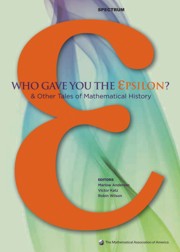Book contents
- Frontmatter
- Introduction
- Contents
- Analysis
- Geometry, Topology and Foundations
- Foreword
- Gauss and the Non-Euclidean Geometry
- History of the Parallel Postulate
- The Rise and Fall of Projective Geometry
- Notes on the History of Geometrical Ideas
- A note on the history of the Cantor set and Cantor function
- Evolution of the Topological Concept of “Connected”
- A Brief, Subjective History of Homology and Homotopy Theory in this Century
- The Origins of Modern Axiomatics: Pasch to Peano
- C. S. Peirce's Philosophy of Infinite Sets
- On the Development of Logics between the two World Wars
- Dedekind's Theorem:√2 × √3 = √6
- Afterword
- Algebra and Number Theory
- Surveys
- Index
- About the Editors
Dedekind's Theorem:√2 × √3 = √6
from Geometry, Topology and Foundations
- Frontmatter
- Introduction
- Contents
- Analysis
- Geometry, Topology and Foundations
- Foreword
- Gauss and the Non-Euclidean Geometry
- History of the Parallel Postulate
- The Rise and Fall of Projective Geometry
- Notes on the History of Geometrical Ideas
- A note on the history of the Cantor set and Cantor function
- Evolution of the Topological Concept of “Connected”
- A Brief, Subjective History of Homology and Homotopy Theory in this Century
- The Origins of Modern Axiomatics: Pasch to Peano
- C. S. Peirce's Philosophy of Infinite Sets
- On the Development of Logics between the two World Wars
- Dedekind's Theorem:√2 × √3 = √6
- Afterword
- Algebra and Number Theory
- Surveys
- Index
- About the Editors
Summary
1 Dedekind's theorem
When the young Richard Dedekind, newly arrived at the Zurich Polytechnik (now the ETH), had to give for the first time the introductory calculus course, it had repercussions that were eventually to spread far beyond his class of students. He tells us in the introduction to his Stetigkeit und irrationale Zahlen [3] how his search for a satisfactory foundation for the calculus led him, on November 24, 1858, to his construction of the real numbers. (It was a Wednesday.) His immediate objective was to make precise and therefore, he argued, arithmetical the previously vague geometrical appeals to what we now call completeness, and every modern treatment develops lovingly and in detail this crucial property of the real numbers. But in the body of his essay, which is still the most lucid available account of his construction, he points to an equally fundamental achievement. After having described how to define addition, he goes on to say ([3], p. 22):
Just as addition is defined, so can the other operations of the so-called elementary arithmetic be defined, viz., the formation of differences, products, quotients, powers, roots, logarithms, and in this way we arrive at real proofs of theorems (as, e. g. √2 × √3 = √6), which to the best of my knowledge have never been established before.
He then elaborates this opinion in letters to Lipschitz of 1876 [3], and repeats and emphasizes it at the end of the introduction to his later Was sind und was sollen die Zahlen?
- Type
- Chapter
- Information
- Who Gave You the Epsilon?And Other Tales of Mathematical History, pp. 185 - 191Publisher: Mathematical Association of AmericaPrint publication year: 2009



